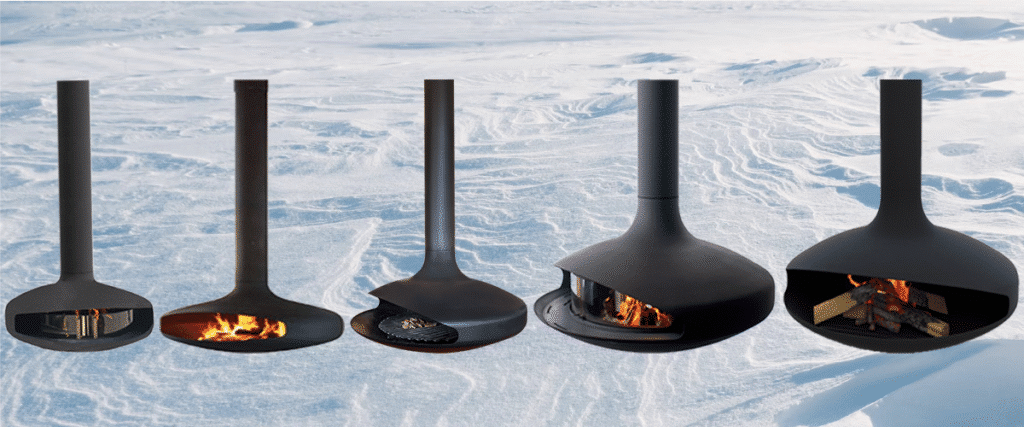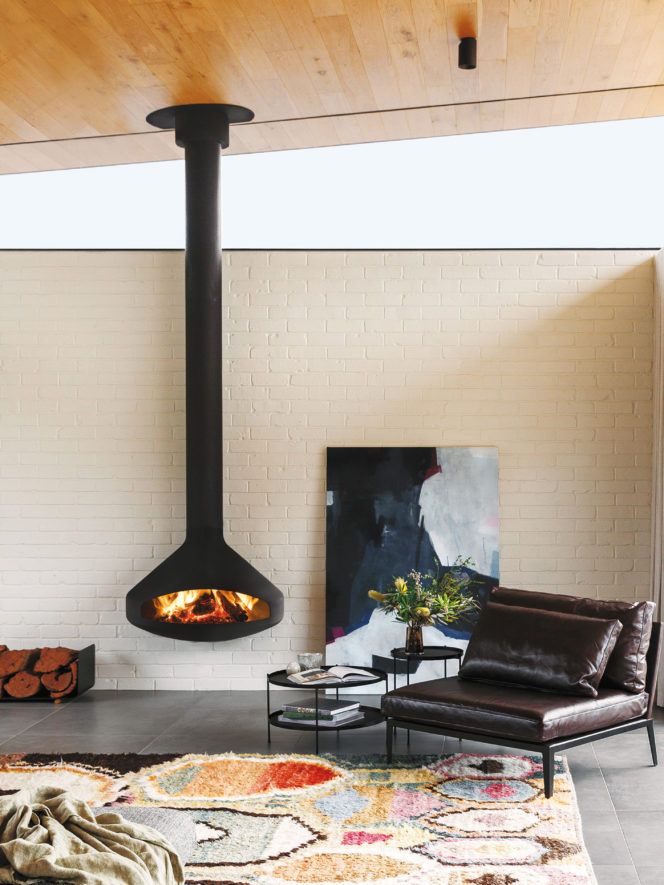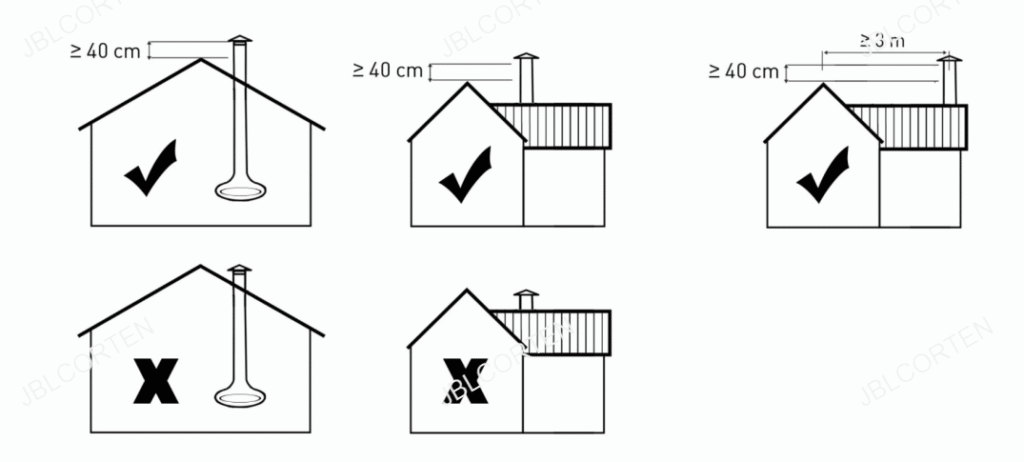
A chimenea colgante es un dispositivo de calefacción y decoración con un diseño colgante, que se utiliza a menudo en modernas salas de estar familiares, espacios abiertos en villas o lugares comerciales de alto nivel. No sólo tiene funciones prácticas de calefacción, sino también un alto sentido del arte visual. Debido a su estructura especial, la instalación de una chimenea colgante es más complicada que la de una chimenea tradicional de pie, y hay que tener en cuenta múltiples factores, como la capacidad de carga, la evacuación de humos, la seguridad y la estética. En este artículo se explican detalladamente los pasos de instalación de una chimenea colgante.
Índice
¿Qué es una chimenea colgante?
Una chimenea colgante, también llamada chimenea flotante, es un dispositivo moderno de chimenea suspendida. Su característica más notable es que está suspendida del techo, y el cabezal del horno suele estar diseñado como un semicírculo abierto o un círculo oblongo, con una forma general sencilla y moderna. A diferencia de las chimeneas tradicionales, las chimeneas colgantes no necesitan empotrarse en la pared, sino que se fijan al techo mediante un sistema de suspensión especial, que puede girar 360 grados para proporcionar calor a toda la habitación.
El diseño de las chimeneas colgantes modernas se centra en la sencillez y la funcionalidad. Suelen estar hechas de materiales metálicos, y la superficie tiene un tratamiento especial, que es a la vez resistente a las altas temperaturas y bonita. El diseño semicircular del cabezal de la estufa no sólo tiene un buen efecto de radiación del calor, sino que también puede controlar eficazmente el proceso de combustión y garantizar la seguridad. Suele haber una cámara de combustión dentro del cuerpo de la estufa, equipada con un sistema completo de entrada y salida de aire para garantizar la combustión completa y la emisión de humos.
¿Qué tipos de estufas colgantes existen?
Según los diferentes combustibles, se pueden dividir a grandes rasgos en tres categorías: chimeneas colgantes de leña, chimeneas colgantes de etanol y chimeneas colgantes eléctricas.

Chimenea colgante de leña
Las chimeneas colgantes de leña son el tipo más tradicional. Este tipo de estufa colgante utiliza leña como combustible, puede proporcionar llamas reales y el aroma único de la leña quemada, creando un ambiente cálido y confortable. Las chimeneas colgantes de leña suelen estar equipadas con un sistema de chimenea para eliminar el humo producido por la combustión.
Con una cámara de combustión lo suficientemente grande, puede garantizar que la leña se queme por completo, controlando al mismo tiempo la velocidad de combustión para evitar que se consuma combustible demasiado rápido. Con una chimenea de leña puede calentar rápidamente la habitación, y el cabezal de la estufa puede girar 360 grados, por lo que puede sentarse en cualquier lugar para observar la llama.
Chimenea de etanol colgante
La chimenea colgante de etanol es un tipo de estufa colgante moderna de combustión limpia que utiliza bioetanol como combustible. La mayor ventaja de este tipo de estufa colgante es que
arde limpiamente, no produce humo ni gases nocivos, por lo que no requiere un sistema de chimenea y su instalación es relativamente sencilla. La llama producida por la combustión del alcohol presenta un bonito color azul o naranja, que tiene un fuerte efecto decorativo.
El diseño de las chimeneas de etanol suspendidas suele ser más conciso, y en el interior del cuerpo del horno se instala un quemador especial para controlar el suministro y la velocidad de combustión del combustible. El quemador suele ser de acero inoxidable o de otros materiales resistentes a altas temperaturas, y su superficie está especialmente tratada, lo que le confiere belleza y durabilidad.
Además, si desea apagar la llama de este horno colgante a mitad de camino, también es muy sencillo. Basta con tapar la tapa de la cámara de combustión para apagarla inmediatamente.
Sin embargo, el rendimiento térmico de las chimeneas colgantes de etanol es relativamente bajo, desempeña principalmente una función decorativa y su efecto calorífico es limitado. El coste del combustible también es relativamente alto, y hay que comprar regularmente combustible especial de bioetanol. Durante su uso, hay que prestar atención al almacenamiento y la manipulación del combustible para garantizar la seguridad.
Chimenea colgante eléctrica
Las chimeneas eléctricas colgantes utilizan la electricidad como energía y generan calor a través de elementos calefactores eléctricos. Este tipo de hornos colgantes suelen estar equipados con luces LED u otros dispositivos de visualización que simulan efectos de llama, lo que puede crear un efecto visual similar al de las llamas reales. La mayor ventaja de los hornos colgantes eléctricos es que son fáciles de instalar y se pueden utilizar simplemente conectándolos a una fuente de alimentación.
El diseño de chimeneas suspendidas suele adoptar un moderno sistema de control electrónico que puede controlar con precisión la temperatura y el efecto de la llama. Los elementos calefactores eléctricos suelen ser de cerámica o cuarzo, que pueden generar calor rápidamente y tienen un alto rendimiento térmico. Suele haber un sistema de ventilador dentro del cuerpo del horno para promover el flujo de aire caliente y mejorar el efecto de calentamiento.
Las ventajas de este tipo de chimenea colgante son que es segura de usar, no implica llamas abiertas y no produce gases nocivos de la combustión. Es fácil de instalar y no requiere chimeneas ni tuberías de gas, por lo que es adecuada para diversos entornos residenciales. Es fácil de manejar y puede controlarse con un mando a distancia o un smartphone, con funciones como la temporización y el ajuste de la temperatura.
Proceso de fabricación de colgantes Chimenea
Selección de materiales
El cuerpo principal del horno suele ser de acero de alta calidad o acero inoxidable, que tiene una buena resistencia a las altas temperaturas y a la corrosión. El grosor del acero suele ser de entre 3 y 5 mm, lo que permite soportar altas temperaturas sin ser demasiado voluminoso. El tratamiento de la superficie suele ser por pulverización a alta temperatura o tratamiento de oxidación, que no sólo es bonito, sino que también puede mejorar la durabilidad.
El interior de la cabeza del horno suele estar revestido de materiales refractarios como ladrillos refractarios, mantas de fibra refractaria o hormigones refractarios. Estos materiales pueden soportar altas temperaturas de más de 1.000 grados Celsius y proteger el cuerpo del horno de posibles daños. El diseño de la cámara de combustión debe tener en cuenta la dilatación y contracción térmicas, y se utiliza un método de conexión especial para garantizar que no se agriete a altas temperaturas.
El sistema de chimenea utiliza tubos de acero al carbono de doble capa, la capa interior se utiliza para la evacuación de humos y la capa exterior para el aislamiento térmico. Para la conexión de los tubos se utilizan juntas de chimenea profesionales que garantizan la estanqueidad y la seguridad. El sombrerete de la chimenea suele ser de acero inoxidable y está diseñado a prueba de lluvia y viento.
El sistema de suspensión es una pieza clave del horno colgante y suele ser de acero de alta resistencia. El diseño del punto de suspensión debe tener en cuenta el peso del cuerpo del horno y la carga dinámica durante el uso para garantizar la seguridad. El mecanismo de suspensión suele adoptar un diseño de junta universal para permitir que el cabezal del horno gire 360 grados.
Tecnología de transformación
La tecnología de tratamiento del horno colgante es relativamente compleja y requiere múltiples procesos.
1. Corte y conformado del acero: El corte por láser o por plasma suele utilizarse para garantizar la precisión del corte y la calidad de la superficie. La forma semicircular del cabezal del horno suele formarse mediante estampación o hilado, lo que requiere moldes y equipos profesionales.
2. Soldadura: La soldadura del cuerpo del horno generalmente adopta soldadura por arco de argón o soldadura con protección de CO2 para garantizar la calidad y el sellado de la soldadura. Después de la soldadura, se requiere la inspección de la soldadura y la prueba de presión para garantizar que no haya fugas.
3. Tratamiento de superficies: Suele incluir procesos de pretratamiento como esmerilado, limpieza y eliminación de óxido, seguidos de pulverización o tratamiento de oxidación. La pulverización suele adoptar la tecnología de pulverización electrostática para obtener un espesor de revestimiento uniforme. El tratamiento de oxidación puede formar una capa protectora en la superficie metálica para mejorar la resistencia a la corrosión.
4. 4. Montaje: Ensamble cada componente de acuerdo con los requisitos de diseño. Durante el proceso de montaje, debe prestarse atención a la precisión de coincidencia de cada componente para garantizar el funcionamiento y el aspecto generales. El quemador, el sistema de control, el dispositivo de seguridad, etc. deben instalarse y depurarse de acuerdo con las especificaciones.
¿Qué hace el Flotante Chimenea ¿En qué consiste?
Cabeza de horno: El cabezal del horno es la parte central de la chimenea colgante, normalmente diseñada en forma semicircular u oblonga. Esta forma no solo es bonita, sino que también tiene un buen efecto de radiación térmica.
Cámara de combustión: La cámara de combustión se encuentra en el interior del cabezal del horno. La parte inferior de la cámara de combustión suele estar equipada con una zona de colocación del combustible. En las estufas colgantes de leña, es aquí donde se quema la leña; en las estufas colgantes de etanol, aquí se instala un quemador de alcohol.
Chimenea: Se utiliza principalmente para eliminar el humo generado por la combustión. La chimenea suele partir de la parte superior del cabezal de la estufa, pasa por el interior de la habitación y, finalmente, se extiende hasta el exterior del tejado. La dirección de la chimenea debe diseñarse razonablemente para reducir al mínimo los codos y las secciones horizontales, a fin de garantizar que el humo pueda evacuarse sin problemas. Deben instalarse orificios de limpieza donde sea necesario para facilitar la limpieza periódica de la ceniza acumulada en el interior de la chimenea. El sistema de soporte de la chimenea también es muy importante, y es necesario garantizar que la chimenea pueda mantenerse estable en diversas condiciones.
Capuchón de chimenea: Se instala en la parte superior de la chimenea para evitar la entrada de agua de lluvia y el reflujo del viento. El sombrerete de chimenea suele ser de acero inoxidable y está diseñado con estructuras a prueba de lluvia y viento.
¿Cómo instalar una estufa colgante?
La instalación de una chimenea colgante debe tener en cuenta muchos factores, como la ubicación de la instalación, la distancia de seguridad, la estabilidad estructural, etc.
1. Elija un lugar de instalación adecuado
- Garantice una distancia de seguridad suficiente respecto a paredes, muebles y techos.
- Se recomienda instalarlo en el centro de la habitación o cerca de una pared resistente al fuego.
- Asegúrese de que la altura del suelo es suficiente (por lo general, se necesitan 2,5-3,5 metros o más de espacio).
2. Reforzar la estructura del techo (si es necesario)
- Pida a un profesional que compruebe si las vigas del suelo o las vigas estructurales de su casa son suficientes para soportar el peso de la chimenea colgante.
- Utilice soportes de estructura de acero o añada bases de montaje para reforzar a través de varias vigas.
- Si se trata de un techo de hormigón, pueden utilizarse tornillos de expansión de alta resistencia o anclajes químicos.
3. Instale los soportes de techo o las placas de montaje
- Utilice un nivel láser o un nivel para asegurarse de que la chimenea está instalada verticalmente.
- Taladra agujeros en el techo siguiendo las instrucciones del producto y fíjalos con los tornillos especiales suministrados.
- Fije firmemente el soporte de montaje o el ojo del horno colgante a la viga estructural.

4. Conecte el tubo de escape/chimenea (para combustión de leña)
- Instale el tubo de la chimenea y páselo a través del techo o tejado para evacuar el humo al exterior.
- Utilice accesorios como aislantes ignífugos, materiales aislantes y tapajuntas para tejados.
- Tenga en cuenta que el ángulo de inclinación y la altura de la chimenea deben cumplir la normativa local.
5. Colgar el cuerpo de la chimenea
- Cuelga el cuerpo en el soporte del techo con la ayuda de otras personas.
- Nuestra chimenea tiene una función giratoria, por favor asegúrese de que gira suavemente después de la instalación.
6. Inspección y pruebas
- Compruebe si todos los tornillos están apretados y la carrocería está vertical.
- Comprobar la ventilación de la chimenea
- Realice la primera prueba de encendido para observar si hay salida de humos o la carrocería tiembla.
Se recomienda encargar a profesionales la instalación de la chimenea suspendida. Si tiene alguna duda sobre la instalación, puede ponerse en contacto con nosotros.
Elegir una chimenea colgante como dispositivo de calefacción del hogar no sólo puede proporcionar calor y confort, sino también añadir una atmósfera artística única al entorno doméstico. Mediante un diseño razonable y una instalación correcta, la chimenea colgante se convertirá en una parte indispensable e importante de la vida familiar, aportando calidez y belleza a la vida familiar.
Espero que este artículo sirva de referencia y orientación útiles para los usuarios que se disponen a instalar una estufa colgante, y ayude a todos a comprender y utilizar mejor este moderno equipo de calefacción. Mientras disfruta de la calidez y el confort que aporta la chimenea flotante, también debe prestar atención al uso seguro y al mantenimiento regular para garantizar el funcionamiento estable a largo plazo del equipo.




